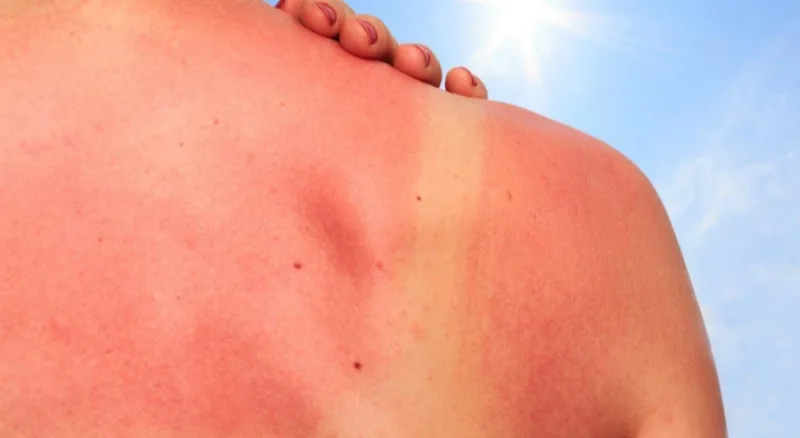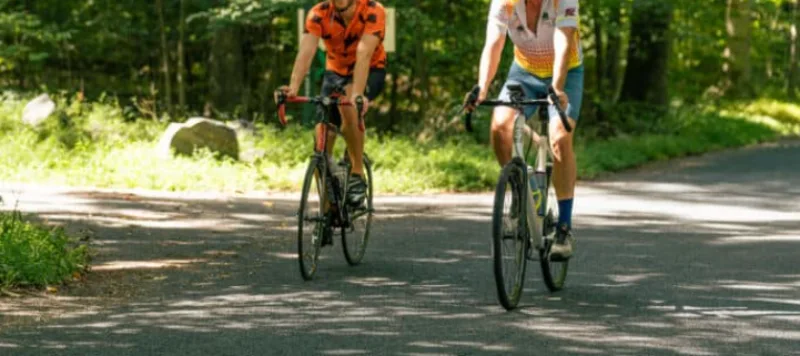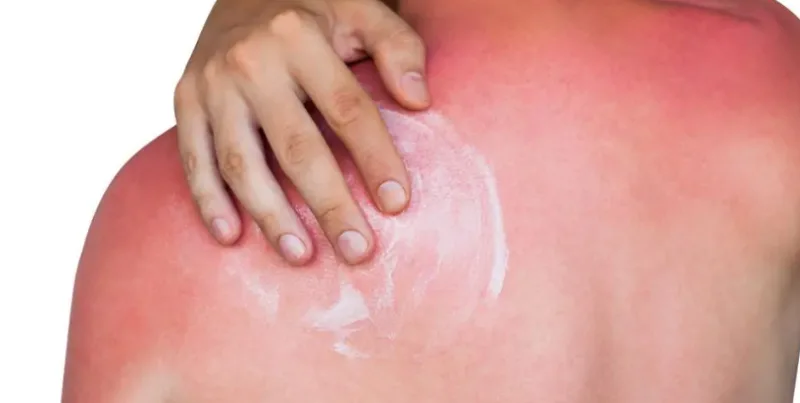Cycling tan lines can pose health risks. Skin darkens when exposed to UV radiation, resulting in melanin production. Prolonged exposure can cause permanent skin damage, such as wrinkles, spots, and even skin cancer.
Yes, sunburn can eventually turn into a tan, but this process involves damage to the skin. For cyclists, prolonged exposure to the sun often leads to sunburn, which may heal and darken into a tan.
In this blog post, we’re diving deep into understanding the effects of sunburn becoming a tan for cyclists, presenting effective strategies for prevention, and sharing some tips to help you tackle those annoying sunburn-induced tans after a long day of cycling.
Does Sunburn Turn To Tan For Cycling: 8 Effects

Cyclists who spend long hours under the sun are at risk of sunburn, which may eventually develop into a tan. While a tan might be perceived as a healthy glow, it shows skin damage. Cyclists must understand that sunburns can become tans immediately and in the long run. Here are some effects of sunburn turning into a tan for cyclists:
- Delayed Skin Repair: After sunburn, the skin may undergo a repair process, which can lead to tanning. However, this process can be slow, and the skin might still be damaged or sensitive, affecting ride comfort.
- Increased Risk of Sun Damage: Tanning after sunburn shows that the skin has been exposed to UV radiation. Repeated exposure, even as it turns into a tan, increases the risk of long-term sun damage, such as premature aging and skin cancer.
- Changes in Skin Texture: As the skin repairs itself from sunburn, it may become rough or leathery. This can affect the comfort of cycling gear and may lead to irritation.
- Uneven Tanning: Areas of sunburn may tan unevenly compared to the surrounding skin, leading to inconsistent skin tone. This might be noticeable, especially if cyclists have areas of their skin that are frequently exposed.
- Sensitivity and Discomfort: Even if the skin tans, it can still be sensitive and prone to discomfort, which might interfere with cycling activities and gear fit.
- Potential for Hyperpigmentation: Sunburn can lead to dark spots or hyperpigmentation as it heals. These spots might become more noticeable and affect the skin’s overall appearance.
- Increased Risk of Peeling: Sunburned skin that turns into a tan may be more prone to peeling as it continues to heal, which can be uncomfortable and affect the skin’s appearance.
- Impact on Performance: Discomfort and sensitivity from sunburn can distract or hinder performance during cycling sessions. Ensuring proper sun protection can help avoid these issues.
8 Best Ways To Avoid To Tan When Cycling
The pleasure of cycling is that it allows you to stay active, explore your surroundings, and enjoy the fresh air. However, it also comes with the risk of developing unsightly tan lines, particularly if you’re in the sun for extended periods. Fortunately, there are effective strategies to help you avoid these tan lines and keep your skin looking even-toned. In this guide, we’ll explore the best ways to prevent tan lines while cycling, from choosing the right gear to managing sun exposure.
Cover Up with High-SPF Clothing
- Long-Sleeve Jerseys: Opt for cycling jerseys with long sleeves made from breathable, moisture-wicking fabrics. Modern cycling jerseys are lightweight and comfortable, even in hot weather, while providing coverage for your arms.
- Leg Warmers: Incorporate leg warmers into your cycling wardrobe. These can be worn over your shorts and provide coverage for your legs, helping to prevent tan lines on your thighs and calves.
- High-SPF Fabrics: Look for clothing specifically designed with UPF (Ultraviolet Protection Factor) ratings. These fabrics are engineered to block UV rays more effectively than standard clothing.
Apply Sunscreen Generously
- Choose a High-SPF Sunscreen: Wear a sunscreen with at least a 30 SPF. This product will protect UVA and UVB rays. Wear high-SPF clothing to protect your skin from the sun. Long sleeves and leg warmers can help minimize tan lines.
- Apply sunscreen Before Riding: Apply sunscreen to exposed areas and reapply during long rides. Cover your face, neck, and hands, as these areas are often left unprotected.
- Reapply Regularly: Apply sunscreen at least every two hours, or more frequently if you’re sweating heavily. Waterproof sunscreens are a good option for longer rides.
Ride During Off-Peak Hours And Choose Shaded Routes

- Seek Shaded Routes: Choose routes that offer natural shade, such as tree-lined paths or roads with ample coverage. Riding in the shade can help limit direct sun exposure and reduce tan line formation.
- Ride Early or Late: The sun’s intensity is lower during the early morning and late afternoon. Try to schedule your rides during these times to avoid the harshest rays.
Wear Sunglasses and a Hat
- Sunglasses: Wear sunglasses with UV protection to shield your eyes from harmful rays. This also helps prevent sunburn around the eyes and reduces the likelihood of tan lines on your face.
- Hat with a Peak: A hat with a peak or brim can shade your face and neck. Look for hats designed for sun protection that offer additional coverage.
Stay Out of the Sun During Peak Hours
- Avoid Midday Rides: Plan your rides outside of these peak hours to avoid the strongest sun rays. Riding early in the morning or later in the evening can help you enjoy your ride while minimizing sun exposure.
- Monitor the UV Index: Before heading out, check the UV index for your area. If it is high, limit your sun exposure or choose a different time to ride.
Wear the Right Gear
- Cycling Gloves: Choose gloves that offer full coverage for your hands. This can help prevent tan lines on your fingers and wrists.
- Full-Length Cycling Pants: Instead of shorts, consider wearing full-length cycling pants that provide coverage for your legs. These are especially useful on longer rides.
Lather Up with Sunscreen
- Use Sunscreen Sprays: For ease of application, consider using sunscreen sprays that are quick to apply and cover large areas effectively.
- Reapply Frequently: Sweat and water can reduce the effectiveness of sunscreen. To ensure continuous protection, apply sunscreen every two hours or after exercising.
Know Your Skin
- Assess Your Skin Sensitivity: If you have sensitive skin or are prone to sunburn, take extra precautions, such as applying higher SPF sunscreen and wearing more protective clothing.
- Monitor Tanning Patterns: Pay attention to how your skin tans and burns. This can help you adjust your protective measures to avoid uneven tanning.
5 Tips For Removing Sunburn-Induced Skin Tanning
Cycling under the sun is exciting, but it can also result in sunburn and skin tan. While prevention is the best strategy, sometimes the damage has already been done. This guide will help cyclists understand how to remove skin tan caused by sunburn through natural remedies, skincare products, and professional treatments.
Aloe Vera
A widely recognized benefit of aloe vera is its soothing and healing properties. You can use aloe vera gel directly on sunburned and tanned areas. Aloe vera helps to cool the skin, reduce inflammation, and promote healing.
- It is possible to extract fresh gel from aloe vera leaves.
- Apply generously to the affected areas.
- Leave it on for at least 30 minutes before rinsing off with cool water.
Cucumber and Tomato
Cucumbers and tomatoes both have natural bleaching properties that can help lighten tanned skin.
- Blend cucumber and tomato to create a smooth paste.
- Apply the paste to the tanned skin.
- Leave it on for 20-30 minutes, then rinse with cold water.
Yogurt and Turmeric
Yogurt contains lactic acid, which can exfoliate and lighten the skin. Turmeric has also been shown to have anti-inflammatory and skin-brightening properties.
- A teaspoon of yogurt and a pinch of turmeric should be mixed.
- Apply the mixture to the tanned areas.
- Leave it on for 20 minutes before washing off with lukewarm water.
Sunscreen

While sunscreen doesn’t remove tan, it prevents further damage. To protect your skin during rides, use a broad-spectrum sunscreen with an SPF of at least 30.
- Apply generously to all exposed areas 15 minutes before going outside.
- Reapply every two hours or after sweating.
Exfoliating Scrubs
Exfoliating helps remove dead skin and lighten tan.
- Choose a scrub with natural exfoliants like sugar or oatmeal.
- Wet skin should be gently massaged with the scrub in a circular motion.
- Rinse off with lukewarm water.
- Exfoliate 2-3 times a week for best results.
Conclusion
Cycling while sunburned and tanned isn’t just about looks; it’s also about your skin’s health and comfort. Understanding these effects, such as delayed skin repair and the risk of hyperpigmentation, can help you take proactive steps to protect your skin. Remember, prevention is always better than cure.
By following the right sun protection strategies and choosing appropriate gear, you can enjoy your rides without compromising your skin’s health. Keeping these tips in mind will help you keep your skin looking great and feeling comfortable, no matter how long you spend under the sun.
FAQs
How Long Do Tans Last?
Most natural tans last 7-10 days, varying depending on skin tone and type. Exposure to the sun during that 7-10 day period may prolong your tan, so how long it lasts depends on you.


